|

Size: Elk weigh 230 to 450 kg (500 to 1,000 lb.) and stand 0.75-1.5 m (2.5-5 ft.) high at the shoulder. Their antlers usually measure 1 to 1.5 m across, tip to tip. Males weigh more than females, but the difference is less compared with other elk subspecies where the males may weigh twice as much as females.
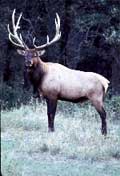 Rocky Mountain elk bulls weigh 300-370 kg (700-800 lb) and cows 200-250 kg (450-550 lb). Bulls may stand five feet at the shoulder, with legs three feet long and body lengths of eight feet. Their coloration is generally tan with dark brown legs, neck, head and belly, with a buff colored rump. Bulls may be lighter colored than cows, appearing silver at times. White and silver colored animals do not appear in the wild. Antlers of mature bulls usually have six or more points per side with main beam lengths of 1.5 m (5 ft), inside spreads may reach 48 inches. Rocky Mountain elk bulls weigh 300-370 kg (700-800 lb) and cows 200-250 kg (450-550 lb). Bulls may stand five feet at the shoulder, with legs three feet long and body lengths of eight feet. Their coloration is generally tan with dark brown legs, neck, head and belly, with a buff colored rump. Bulls may be lighter colored than cows, appearing silver at times. White and silver colored animals do not appear in the wild. Antlers of mature bulls usually have six or more points per side with main beam lengths of 1.5 m (5 ft), inside spreads may reach 48 inches.
 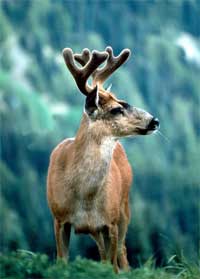
Population Decline: The current elk population of the United States is estimated to be about one-tenth of the historic level. The population along with most other North American game animals reached a low point around 1900. However populations have rebounded with controls on hunting. There were estimated to be 782,500 elk in North America in 1989. About 72,000 then lived in Canada. Some 20,000 are in ranches where they are raised for meat, antlers, or for hunting.
Habitat: One of the largest North American and Asian game animals, they live in open forest and near forest edges in similar environment as deer. In mountain regions, they are known for living in rugged high elevations during the summer, and in winter they gather in lower areas with more shelter.
Possible Advertisement
Contrary to popular belief, the Rocky Mountain elk was not an animal of the plains that retreated to the mountains because of the encroachment of man. Elk always lived in the Rocky Mountains. Rocky Mountain elk currently inhabit the Rocky Mountains from central British Columbia and Alberta through Idaho, Montana, eastern Washington, eastern Oregon, northeastern Nevada, Utah, Arizona, New Mexico, Colorado, Wyoming, the western portions of North and South Dakota. There are scattered populations of transplanted animals in many other states; western Nebraska, northeast Minnesota and northern Michigan among them. The current North American elk population is about 800,000. The largest herd of elk lives in Yellowstone National Park. It consists of about 30,000 elk that gather together from about 7 herds to spend the summer.
Antler Shedding: The bull usually loses his antlers in the spring. And then starts to regrow them during the summer. Elk live up to 18 years old but the average is between 7 and 10.
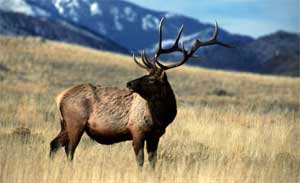 Summer: In the summer the elk usually graze and live in the high mountains in the forest and deep brush. They will also occasionally wander into some of the high meadows to feed; while keeping close to the cover of the trees for protection. Summer: In the summer the elk usually graze and live in the high mountains in the forest and deep brush. They will also occasionally wander into some of the high meadows to feed; while keeping close to the cover of the trees for protection.
In the summer they usually graze on grass and small tree sapling and green twigs. When the grass dries they chew on bigger saplings, eat mushrooms, and also eat on berries. Elk generally feed an hour before to an hour after sunset and the same at sunrise. The rest of the day they mainly stay bedded down in heavy cover and sometimes they will move around. And graze a little bit in the middle of day if they feel safe.
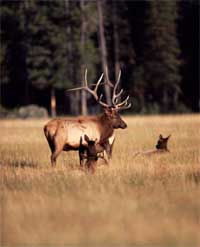 Fall And Winter: In the fall and winter they migrate to the lower valleys and wooded slopes. And they eat dried grass and shrubs. They also eat berries and the bark off of small trees. Fall And Winter: In the fall and winter they migrate to the lower valleys and wooded slopes. And they eat dried grass and shrubs. They also eat berries and the bark off of small trees.
Spring: In the spring elk begin to migrate back up to the higher lands where the bulls lose their antlers and rest up from the rut. At these times you won’t see a single bull for quite a few months since they are so tired. During this time they eat the fresh grass and chew on young trees and get very fat and the end of the summer is when elk weigh the most.

The Breeding season for an elk starts in August and goes through October. This time of year for the elk is known as the rut. At the start of the rut a mature bull elk will gather a harem of cows to breed with. He and other bulls will also fight for the leadership of the harem and also over cows so that they can make their harem bigger. An experienced bull may gather a harem of up to 60 cows. And sometimes a bull will let a younger bull join his herd as they move down into the valleys and lower lands for winter.
Young bulls usually will not get a cow to accept them until they are two or three years old so they will hang out with the herd or a larger more mature bull.
The gestation period for a cow is around 8 ½ months. The cows usually give birth to one or more calves in May or June. The newborn calves usually weigh about 30 pounds.

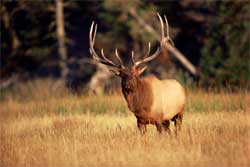 North American elk were once considered a species separate from the Eurasian red deer. Scientists now consider the North American elk and Eurasian red deer to be the same, though distinctions between the two live on in the language. The term wapiti applies to the North American elk and to the wapiti-like red deer subspecies in Eastern Asia where the males resemble the North American elk in their antler structure and mating calls. The American elk, along with Sichuan deer, Alashan wapiti, and Manchurian wapiti were once collectively classified as Cervus canadensis, and the remaining subspecies being classified as Cervus elaphus. North American elk were once considered a species separate from the Eurasian red deer. Scientists now consider the North American elk and Eurasian red deer to be the same, though distinctions between the two live on in the language. The term wapiti applies to the North American elk and to the wapiti-like red deer subspecies in Eastern Asia where the males resemble the North American elk in their antler structure and mating calls. The American elk, along with Sichuan deer, Alashan wapiti, and Manchurian wapiti were once collectively classified as Cervus canadensis, and the remaining subspecies being classified as Cervus elaphus.
All text is available under the terms
of the GNU Free Documentation License
|